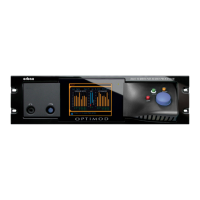OPTIMOD SURROUND PROCESSOR INTRODUCTION
1-13
• A link that passes OPTIMOD 8685’s peak-controlled output does not need as low
a noise floor as a link passing unprocessed audio. However, if the application
calls for high average modulation, the link’s transient response is critical.
• A link that passes OPTIMOD 8685’s peak-controlled output after it has been
coded by the transmission codec requires bit-accurate transmission of the trans-
mission codec’s output. In DTV applications, the 8685 will typically drive a Dolby
Digital encoder at the studio. The link will pass the Dolby Digital encoder’s out-
put to the transmitter, either directly or multiplexed onto a transport stream.
Using Lossy Data Reduction before the 8685’s Input
Many broadcasters are now using lossy data reduction algorithms like MPEG-1 Layer
2, Layer 3, or AAC to increase the storage time of digital playback media and to
transmit audio. Sometimes, several encode/decode cycles will be cascaded before the
material is finally delivered to OPTIMOD 8685’s input.
All such algorithms operate by increasing the quantization noise in discrete fre-
quency bands. If not psychoacoustically masked by the program material, this noise
may be perceived as distortion, “gurgling,” swishing, or other interference. Psycho-
acoustic calculations are used to ensure that the added noise is masked by the de-
sired program material and not heard. Cascading several stages of such processing
can raise the added quantization noise above the threshold of masking, making it
audible.
In addition, at least one other mechanism can cause the noise to become audible at
the radio. OPTIMOD 8685’s multiband limiter performs an “automatic re-
equalization” function that can significantly change the frequency balance of the
program (sometimes by more than 10 dB). This can cause noise that would otherwise
have been masked to become unmasked because the psychoacoustic masking condi-
tions under which the masking thresholds were originally computed have changed.
Accordingly, if you use lossy data reduction before the 8685, you should use the
highest data rate possible. This maximizes the headroom between the added noise
and the threshold where it will be heard. In addition, you should minimize the
number of encode and decode cycles because each cycle moves the added noise
closer to the threshold where the added noise is heard.
For MPEG Layer 2 encoding, we recommend 384kb/second or higher.
Links from the 8685’s Output to a Transmission Encoder or Transmitter
When used as a transmission processor, the 8685’s output should be connected to
the encoder or transmitter (like Dolby’s DP569 Dolby Digital encoder) so that the
link introduces no change in OPTIMOD 8685’s output bitstream. A simple AES3id
connection is ideal. Alternatively, an uncompressed digital link will pass the 8685’s
output with little or no degradation if the link does not truncate word length (from
20 to 16 bits, for example) and does not require downward sample rate conversion.
The 8685’s look-ahead limiters tightly control peak levels at the 8685’s outputs. Lossy
compression following the 8685’s output can decrease system performance because
the compression adds peak level overshoots. Such links must therefore be carefully
qualified before you use them to carry the peak-controlled output of OPTIMOD
8685 to the transmitter. For example, the MPEG Layer 2 algorithm can increase peak

